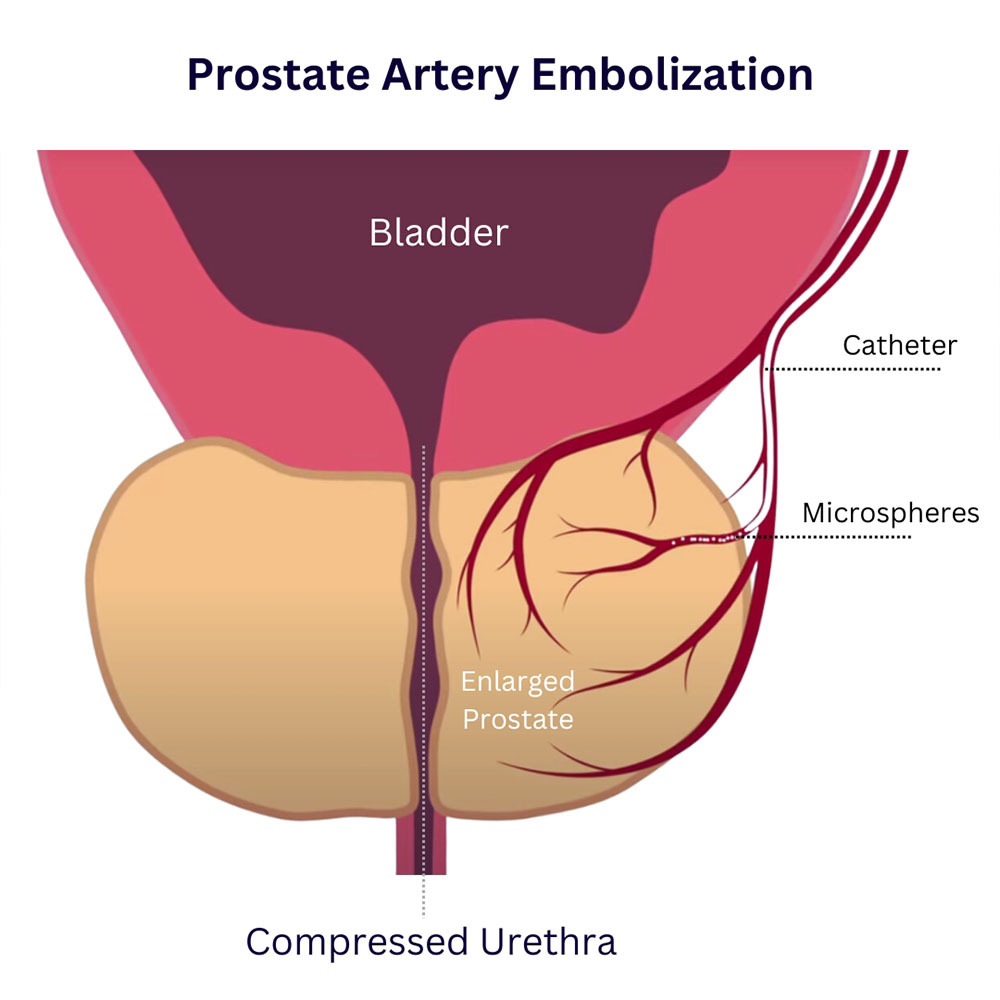
You don’t have to suffer with urinary issues or pelvic pain just because you’re getting older. In fact, there’s a good chance many men will eventually encounter these issues, so it’s best that you know a vein specialist in Brooklyn to treat things like benign prostatic hyperplasia. At Astra Vein & Fibroid Treatment Center, your Brooklyn vein center doctor successfully reduces your symptoms with a treatment called prostate embolization. This minimally invasive procedure helps you avoid embarrassing leakage and other urinary problems. Call this vein clinic in Brooklyn today for a consultation and learn if prostate artery embolization will work for you.
Prostate artery embolization (PAE) is a minimally invasive procedure that treats benign prostatic hyperplasia (BPH) in men. PAE improves lower urinary tract symptoms like frequent urination or difficulty urinating because of an enlarged prostate. Your symptoms are often due to BPH partially blocking your urethra.
A top varicose vein doctor in Brooklyn may recommend this procedure for several reasons, including when you prefer not to undergo traditional prostate surgery. The prostate arterial embolization procedure may target the main branches of the prostate arteries or the small branches to achieve a more precise embolization. PAE is an outpatient procedure and doesn’t require a hospital stay.
Dr. George Bolotin, director of Astra Vein & Fibroid Treatment Center, is an experienced interventional radiologist in Brooklyn who specializes in vascular health concerns. He’s one of the top vein specialist in Brooklyn. He also treats various vein conditions like varicose veins and spider veins.
His team includes the best vein doctors in Brooklyn who offer vein treatments such as:

Sometimes, men report improvement in their erectile dysfunction symptoms after prostatic artery embolization, as it reduces prostate pressure on nearby nerves while improving blood flow.
Prostate arterial embolization shrinks the prostate, which gives relief to such symptoms as:
Your vein doctor in Brooklyn may advise you not to get PAE if there are factors present that might make the procedure less effective or are riskier to put you through. If you have blockages or severe damage in your blood vessels, it would make it difficult to reach the arteries safely.
Other situations in which embolization is considered unsafe include:
Your radiologist may get a urine test or digital rectal exam to assess the size of the prostate. A prostate-specific antigen (PSA) is done to rule out prostate cancer. Your vascular specialist in Brooklyn NY ensures that all required tests and MRIs are done before reaching a final diagnosis and recommendation.
In a prostate embolization, the focus is to shrink the prostate by blocking its blood supply. Your vein doctor may ask you to stop blood thinning medicines to reduce bleeding risks.
The procedure of prostatic arterial embolization includes:
The procedure takes about one and a half hours, and most people go home on the same day. Since it’s minimally invasive, the recovery takes about one to two weeks, and you can usually return to normal activities slowly with some instructions.
At this vein center in Brooklyn, you may have to spend a few hours in the recovery room so the nurse can check your vitals.
Once you’re stable, your Astra doctor gives you post-procedure guidance that includes:
You may feel mild pain and some cramping for a few days, but that passes with little discomfort when you take your pain medication. Common side effects are greatly reduced when you rely on the expertise of your vein specialist in Brooklyn.
Call your NYC doctor immediately, however, if you notice signs such as:
To ensure proper recovery, avoid heavy lifting, sexual activity and driving. Don’t take hot baths or saunas as the heat increases blood flow. Limit alcohol and stay hydrated as much as you can. Your doctor schedules follow-up visits to check your progress and may order a few scans as well.
Symptoms related to benign prostatic hyperplasia are present in about one in four men by age 55 and in half of 75-year-old men. If you have pelvic pain, difficulty urinating or even circulation problems, don’t delay your visit to the best vein center in Brooklyn. Contact Dr. Bolotin at Astra Vein & Fibroid Treatment Center today for an examination.
Vein & Vascular Medical Care
4209 Ave U, Suite A.
Brooklyn, NY 11234
(347) 934-9068
Vein & Vascular Medical Care
869 E Tremont Ave
Bronx, NY 10460
(929) 447-4563
Vein & Vascular Medical Care
30-71 Steinway St
Astoria, NY 11103
(929) 486-2201